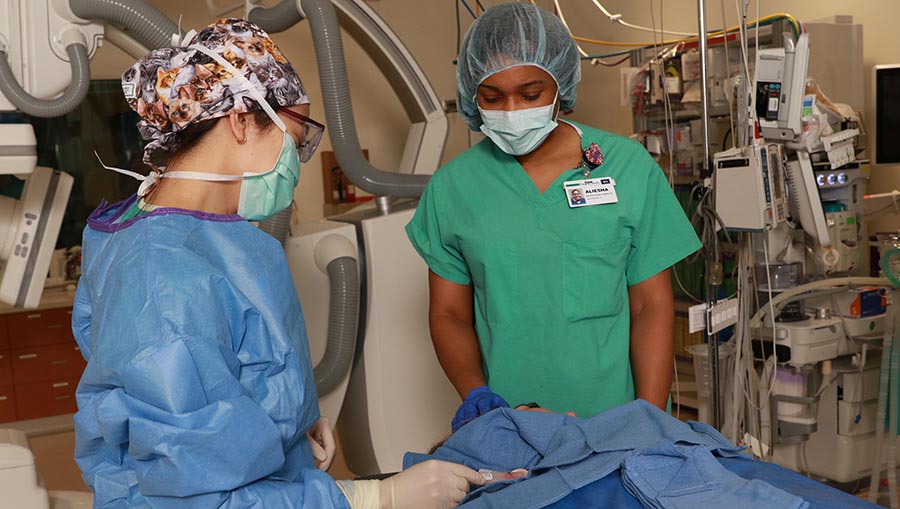Feature image, above: Aliesha Washington, right, an RN at Baptist Health, assists with a procedure. (Photo provided by Baptist Health)
Since the days of Florence Nightingale, nurses have played an invaluable role in patient care. However, nursing shortages have been around for just as long. The Center for American Progress notes that from the very beginning, there have not been enough nurses to meet demand for reasons such as a pool of workers or nurses limited by gender or race or nurses serving abroad during wartime.
Today’s shortage is driven by a multitude of factors, and it is one of the key issues affecting the industry. The Health Resources and Services Administration reported in 2022 a projected shortage of about 78,600 full-time registered nurses in 2025 and about 63,720 in 2030.

The Jefferson Regional School of Nursing in Pine Bluff. (Photo provided by Jefferson Regional)
Those numbers have a direct impact on patients. The American Association of Colleges of Nursing notes that multiple studies have shown a greater proportion of professional nurses at the bedside is associated with better outcomes for patients, while large patient loads are associated with higher readmission rates, increased rates of infection and more burnout among nurses.
“When you don’t have enough staff at the bedside, it slows down the entire throughput,” said Michelle Powell, vice president and chief nursing officer at Jefferson Regional Medical Center in Pine Bluff. “It overloads the emergency department.”

Michelle Powell,
Jefferson Regional
Medical Center
She noted a major shortage of medical-surgical bedside nurses as recently graduated nurses, who traditionally filled the role, seek work in speciality areas instead.
“Thirty-plus years ago, people would know when you got out of nursing school, you were going to kind of work at the bedside, at least for a couple years, and then you may look for something different, but I think that is the part that’s changed,” she said. “When people get out of nursing school now, a lot of them are looking for that
Monday-through-Friday job, and I think that’s a little bit of a mind-shift difference from 30 years ago.”
Kelley Hamby, system chief nursing executive at Baptist Health, said the nursing industry is not immune to trends that have caused labor shortages in other sectors, namely a large population nearing retirement age. Coupled with that is the rise of specialty areas relatively new to nursing, such as nurse practitioners and nurse anesthetists.

Kelley Hamby, Baptist Health
A physician shortage, particularly in rural areas, has increased the demand for nurse practitioners, she said. She agreed that med-surg nurses are in high demand and added that other areas in need of workers include emergency rooms, critical care, neonatal intensive care units, and mental and behavioral health.
Powell noted the high turnover rate among newly graduated nurses, who are leaving the industry just as quickly as they are entering it.

Top: Olivia Hill, RN at Baptist Health (Photo courtesy of Baptist Health)
“The turnover rate for nurses in their first one or two years is your highest turnover rate. It’s not your nurses that have 10 years of experience. It’s your new nurses with one or two years experience that turn over faster,” she said. “They’re experiencing burnout, compassion fatigue, and I do think it’s a real thing.”
Amanda Irby, chief nursing officer at Conway Regional Health System, agreed that burnout is a leading factor behind the nursing shortage.

Amanda Irby, Conway Regional Health System.
“People go into health care because they want to help others, so there’s a large degree of empathy and compassion with these humans, and I think it’s hard for people to leave that at work sometimes,” she said. “Over time, that begins to wear on folks, and they sometimes will get to the point where they’re like, ‘I’ve got to go work as an accountant and just deal with spreadsheets and not deal with people or feelings.’”
Hamby said Baptist encourages employees to prioritize their mental health.
“We provide care, and so sometimes you forget to take care of yourself and you forget the well-being of yourself,” she said. “We’re really trying to encourage those things, like, you know, take a break. Make sure you take your break today. Go outside. Enjoy some time away from the unit and from the patients and from the families.”
With rising costs and stagnant reimbursement rates, hospitals are having to be creative about ways to make staff feel appreciated, Powell said. While Jefferson Regional, like many hospital systems, offers wellness memberships and employee assistance programs, she said the most important part of cultivating mental well-being among employees is company culture.
“We work really hard on transparency so staff feel like they’re part of a team. I think the teamwork and feeling like you belong, people are going to work harder when they feel like they’re truly part of a team, like they’re making a difference, and I think it comes from having great staff, great leadership.” she said. “It’s a culture. I think culture plays a huge piece in burnout, staff feeling appreciated.”
Culture is also key at Conway Regional, which ensures nurses have a voice in the organization through inclusion in a multidisciplinary shared-governance structure.
“It’s called our clinical congress,” Irby said. “All the groups come together. This gives nurses a voice in their practice and a voice in the care that they’re delivering. Leaders listen very, very heavily to ideas and suggestions that the front-line staff are bringing about.”
Jefferson Regional is working to add more nurses to the workforce by beefing up its school of nursing, which it recently moved from a 10,000-square-foot facility into a 16,000-square-foot facility to allow for increased enrollment. Jefferson Regional can employ most every graduate at the hospital or at one of its physician practices, making the school an important tool for recruitment and retention.
“Having our own local school has been a great thing for us because students get to have clinical rotations in the facility and kind of make those connections, so that’s one way it’s been a great thing for us to be able to retain that staff,” Powell said. “I think being in south Arkansas, it’s a little harder to recruit people to this area. There’s not as many things to offer people.”
She added that nursing salaries have increased in recent years, and it is difficult for hospitals to stay competitive while maintaining balanced budgets. She said her hospital works to keep overtime to a minimum while focusing on retention efforts such as flexible scheduling and employee satisfaction.
Meanwhile, Baptist is working to bring more students into the nursing programs at Baptist Health College Little Rock by recruiting at the high school level, including through a program that allows students to graduate from high school ready to become licensed practical nurses and by offering more scholarships for students.
While Conway Regional does not operate a nursing school, it offers a nurse residency program that provides additional support to new-graduate hires.
“That is a nice recruitment tool,” Irby said. “It gives our new grads a whole lot of support, a whole lot more support than they would have if they just hired onto a unit and did that as a traditional orientation program.”
The hospital system also provides a tuition reimbursement program that allows nurses to grow their careers, which not only boosts staff morale but also helps recruit and retain employees, she said.
New technologies play a complex role in the industry. Hamby said Baptist Health uses virtual nursing programs to free up time for bedside nurses by having a remote nurse handle admissions.
“The medical history can be a little consuming, especially depending on how well you are or how sick you are, to ask those questions and to go through that in-depth review with the patient and enter all that into the medical record of the patient,” she said. “We now can do that virtually and give time back to the nurse at the bedside to do other things that require the nurse at the bedside to do.”

The Med Flight team at Baptist Health (Photo courtesy of Baptist Health)
However, introducing new technology has a downside. Irby said the large number of boxes to check and fields to enter when it comes to electronic charting can sometimes leave nurses feeling like they are nursing a computer, rather than a patient.
“Some of the very tenured nurses who are used to sitting at a patient’s bedside with no chart, no nothing and just interacting with the patient and doing patient care feel like it is impersonal,” she said. “They don’t like having a laptop or computer in the room or at the bedside because they feel like it is taking their focus away from the patient and almost giving the patient a bad perception that the computer’s more important than they are, and that’s obviously not the case at all.”
Powell agreed that electronic medical records have both benefits and drawbacks. While EMRs can increase efficiency, they also add to the cost burden faced by hospitals, she said.
“Multiple people can access the chart. Physical therapy’s in the same chart that you’re in, dietary, the physician, and so that has been a huge win in health care,” she said, “but I think on the other side of it, the cost for the electronic health records, for all this new technology, is very expensive.”

Nurses Jacob Rogers, left, and Angie Tyson. (Photo courtesy of Conway Regional)
Medical charting is likely to be one of the aspects of nursing most impacted by artificial intelligence and machine learning, Hamby said, adding that electronic medical records can use various kinds of patient data to provide risk scores and other assessments.
Smart pumps that connect to charts to ensure IV drips are appropriate for each patient and smart beds that monitor for bed sores and alert staff when patients get up are also becoming a frequent sight at hospitals, along with robot-assisted surgery, she said.
She added that she expects the technological advancements to lead to a greater demand for informaticists who can analyze the data being collected by the machines and help hospitals use that data to better care for patients.

Nurses Harley Emery, from left, Emily Alvey and Daley Chavis. (Photo courtesy of Conway Regional)
Irby said she expects the nursing shortage to continue, but she believes there will always be people drawn to the industry because they want to make a difference.
“They either were a patient themselves or they have a loved one who may have experienced an unexpected admission, a traumatic surgery, a cancer diagnosis, etc., and they got to see the impact that these bedside nurses make on a patient and, like, ‘I want to be that person for someone,’” she said. “Despite having a shortage, we will still have people that want to go into nursing to take great care of patients, to give back to their community and to help leave the world a little bit better than they found it.”
READ ALSO: Arkansas Graphics, TCPrint Solutions Merge to Expand Services



